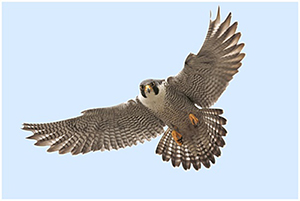Home → Fish & Wildlife → Wildlife → Living with Wildlife → How to Avoid or Resolve a Wildlife Conflict → Birds of Prey
Birds of Prey

Peregrine falcon in flight photo by Peter Green
Overview
Focused conservation and management of Maine’s raptors, including owls, falcons, hawks, eagles, harriers, osprey, and vultures, has led to increases in populations, although some are still listed as threatened or endangered. Remember that it is illegal to kill any bird of prey.
Birds of prey or raptors have hooked beaks for tearing flesh, sharp talons for gripping, wide wings and light bodies for hunting, and feathers specifically designed for fast, quiet flight. Humans have been captivated by the impressive flight skills and hunting prowess of raptors. Declines in many raptor populations and conservation efforts to aid them have further elevated our awareness.
Conflict Resolution
Protect Domestic Animals
Enclose domestic animals — Free-roaming chickens, ducks, turkeys, pigeons, small domestic rabbits, and similar animals are susceptible to predation. House domestic birds in a durable, fenced enclosure that will allow the birds to safely eat and loaf outside during the day. Such a structure can be constructed with a wooden framework that is entirely covered with one-inch poultry wire or similar netting. This outdoor run can be permanent and attached to a coop or other building or be portable and moved periodically.
Where a complete and permanent enclosure isn't practical or desirable, provide escape cover. You can construct escape cover by placing planks, plywood, or chicken wire placed over logs, rocks, or bricks. This outdoor area should be at least seven by seven feet and the cover should be a foot off the ground.
Install scare devices — A variety of devices can frighten a problematic bird of prey. Increasing human activity in the area will keep most birds of prey at a distance. Yelling and clapping hands, firing a gun loaded with blanks (it is illegal to shoot any birds of prey), and banging cans together are all effective.
The "hawk globe" is basically a round mirror designed to scare an attacking hawk or owl. If it is placed in the flight path the owl uses, an attacking bird will see its reflection and retreat, giving domestic birds a second chance. Because owls hunt on their own, they may avoid returning to a place where they perceive competition from another owl.
Protect Yourself from Dive-bombing Birds of Prey
Most aggressive behavior from birds of prey occurs when they are defending their territory, homes, mates, or young. Not all species of raptors are aggressive near nesting areas, however in woodland areas barred owls, great horned owls, and American goshawks can be aggressive, and in cliffs, quarries, or other urban sites such as lighthouses, bridges, and buildings, peregrine falcons may aggressively defend their nest. Please report any observations of aggressive peregrines to Erynn Call, MDIFW Raptor Specialist, at erynn.call@maine.gov. Click here for peregrine falcon identification resources.
When possible, stay away from nesting areas with aggressive birds until the young are flying (three to four weeks after eggs hatch) and the parents are no longer so protective. If you must walk past a nest, wave your arms slowly overhead to keep the birds at a distance and wear a hat (or helmet).
Osprey Nest Removal
Ospreys commonly construct sizable stick nests on various structures, including houses, docks, electrical towers, and cell towers. The location of these nests may lead to safety concerns, cause disturbance to the birds, and pose problems for the structures. Permits are required for nest removal during the breeding season, typically from April 1 - September 1, when breeding pairs, eggs, or young ospreys are present, otherwise a permit is not needed. If removal is necessary during the breeding season, please contact the USDA Wildlife Service Maine State Office.
Activity around Bald Eagle Nests
Bald eagles also construct large stick nests that are sometimes on structures, but much more often in large trees. The breeding season for Bald Eagles in Maine is generally February 1 – August 15th. Even though Bald Eagles are not listed as an endangered or threatened species at the federal or state level, they continue to be protected under federal law by the Bald and Golden Eagle Protection Act (Eagle Act). The U.S. Fish and Wildlife Service (USFWS) developed the National Bald Eagle Management Guidelines to detail when and under what circumstances the Eagle Act may apply.
If you are interested in conducting any activities, such as construction/development, maintenance, forestry, use of helicopters or aircraft, blasting/fireworks, recreational activities, or other work within 660 ft of an active or inactive nest, you should reach out to USFWS via the USFWS Eagle Act Review and Consultation page and review Step 4. Activities greater than 660 ft or a half mile for loud activities such as explosions or fireworks, are unlikely to bother nesting bald eagles. Bald eagles may shift and change the location of their nest from year to year, consequently, not all nests are mapped in the state. As information is available, nest status and location are updated via the USFWS Bald Eagle Nest Location and Buffer Zones layer. Learn more about USFWS Eagle Management here.